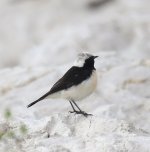bassel
Well-known member
Hello
I got this wheatear yesterday from the coastal area and for me it looks a normal pied wheatear . I am not convinced that this could be a Cyprus wheatear but preferred to post and get your thoughts in regards . So please can you confirm if this is just a pied wheatear .
Thanks
Bassel
I got this wheatear yesterday from the coastal area and for me it looks a normal pied wheatear . I am not convinced that this could be a Cyprus wheatear but preferred to post and get your thoughts in regards . So please can you confirm if this is just a pied wheatear .
Thanks
Bassel









